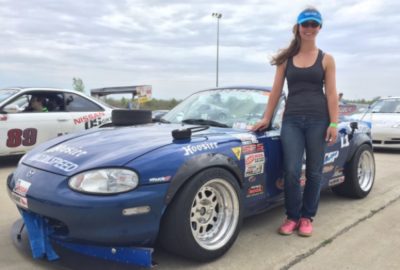Many people blame the car when they encounter problems on course. If the car is doing something they don’t like, such as pushing (where the front end pushes toward the outside of the corner rather than turning in like the driver would like), they assume it is a set up issue and want to tinker with the car to try to fix it. However, frequently the problem lies with the “nut behind the wheel,” according to Tamra Hunt, SCCA Solo National Champ and 2015 SCCA Solo Rookie of the Year.
Hunt (pictured above) explains:
The nut behind the wheel mod is the most difficult one of them all to tighten. There are many ways to identify if the issue lies with the driver rather than the car. For example, if an experienced autocrosser can jump in your car and drive faster than you, then your time may be better spent working on your driving.
All levels of drivers should first first ask: “What driver adjustments can I make to get the car to handle the way I want?”
If you are getting push/understeer exiting the corner, for example, ask yourself: “Should I drive the car deeper into the corner by starting my braking later and holding on the brake deeper (i.e. trail braking deeper), carrying more speed into the corner and therefore have to get to throttle (i.e. gas pedal) later in the corner, which would stop the exit push that exists due to having applied too much throttle too early in the corner?” Yes, that’s a mouthful, but you need to get to the point where it is second nature to identify the problem and brainstorm possible solutions with your driving inputs.
If you get into the habit of this self-reflection, then you are likely going to accomplish one of the main goals you set out to – becoming a better driver. It really can be that simple (albeit a process).
So, how do you learn to identify the issue and instantly brainstorm driving adjustments? Acquire knowledge and experience (like anything, but the question is how). Autocrossers benefit from seat time (i.e. practice on course). Novices and intermediate drivers benefit the most, especially with instruction while forming habits. Experienced autocrossers who can’t seem to be on pace with class leaders despite a competitive car may need an interjection (e.g., instruction) as opposed to continuing to practice their current methods.
Below are the rules of thumb and tips:
For those who are really new to autocross – An SCCA Starting Line School is a great option. As they say, practice doesn’t make perfect, perfect practice makes perfect.
For any level of driver
The best option – Take an autocross school such as an Evolution Driving School. These schools have one purpose: to make you faster. Highly qualified instructors (SCCA Solo National Champions) will instruct you for the day, and even get behind the wheel of your car a few times. You get ample runs in this setting, all with an instructor helping you finesse your driving; it would take you months of regular events to get as many, but without the instructor.
Another good option – Take instructors with you during your runs at your local events. Most clubs have experienced autocrossers available to ride along and give feedback. This is a great opportunity to get free feedback tailored to your driving. The downside of this option is that frequently you will have limited runs for the instructor to get familiar with your driving (you could possibly have a different instructor for each run), so feedback will be less tailored and less consistent than at a school.
A third option – Find a co-driver that is more experienced (i.e. typically faster, but certainly more knowledgeable) than you. They can give you feedback on the car/ a reality check (e.g., “No, it isn’t pushing; in fact, I’m two seconds faster than you on a 60 second course.” – well, hopefully they aren’t this blunt, but you get the point.), and you can analyze videos and/or data together to find areas where the faster driver has varying driving lines or driver inputs.
A fourth option – Consider attaching a Garmin VIRB, GoPro or other video device to your car, positioning it so you can see where you are going, your proximity to cones, and your hands on the steering wheel. (A good option is just behind the driver door.) Post-event, analyze the videos and see if you can identify areas where you can improve. Frequently, other people will post videos to YouTube, and you can compare your videos to theirs for additional perspective.
Or – If you’ve taken all of the above steps and are still looking to find time on the course, start trying different techniques at events. For example, you could spend a few local events focusing on trail braking corners, or verbally calling out corners or critical cones to yourself (forcing you to think/look ahead), or late apexing everything (even if not ideal for the corner) for sake of practicing the skill. Pick one area to focus on and applying the technique for a few events so you can work on muscle memory and visualization.
Thanks for reading and I hope these tips of where you should put your focus will improve your driving and help you find time on the course!


 ACCESSIBILITY
ACCESSIBILITY